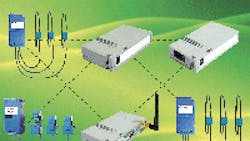Wireless energy meters monitor usage and efficiency
A new extension of the Wi-LEM (Wireless Local Energy Meter) family now allows remote measurement and monitoring of electricity, water, and other metered utilities, as well as temperature and humidity. It lets industrial and commercial enterprises break down energy and water usage and identify areas of efficiency improvement. All of the new Wi-LEM components feature a 10-fold increase of RF power from 1 to 10 mW, increasing the distance between nodes compared to the previous LEM generation of components.
By using the 802.15.4 wireless communication standard, which has proven reliability, along with
split-core transducers, Wi-LEM reduces the time, cost, and disruption involved in deploying a
sub-metering installation, according to company sources.
The Wi-Pulse is a new dual-input pulse counter used to count and transmit pulses generated by utility meters. It can easily be connected to an existing Wi-LEM network, expanding the range of utilities that can be monitored in addition to electricity. Wi-Pulse enables readings from existing standalone water and energy utility meters and sub-meters with a pulse output to be monitored centrally using a Wi-LEM network.
The new Wi-Zone is a temperature and humidity transducer that connects to a Wi-LEM network, allowing environmental conditions to be monitored. Both new devices are battery powered, simplifying installations, as they require no external power supply. They also both feature an internal integrated antenna, making the transducers compact and suitable for retrofit applications.
The Wi-LEM family of Energy Meter Nodes (EMN) has also been enhanced to offer measurements of high currents up to 2,000 ARMS. EMNs provide much more information than a simple sub-meter as they measure active, reactive, and apparent energy plus maximum current and minimum voltage. EMNs comprise an assembly of one to three current transducers with an integral signal-processing module. They can be deployed to measure energy consumption at any point in a power cabinet and transmit the data.
All three units work with the company’s established Mesh Node and Mesh Gate to ensure compatibility with existing solutions. The Mesh Node is a repeater linking various nodes to provide reliable wireless communication in larger installations. It can be added to the network without any need for additional configuration or programming. The Mesh Gate is a standalone wireless network management gateway that connects the self-configuring mesh network of transducers with a PC. Each Mesh Gate allows the monitoring of up to 200 EMNs. For more information, visit LEM.
